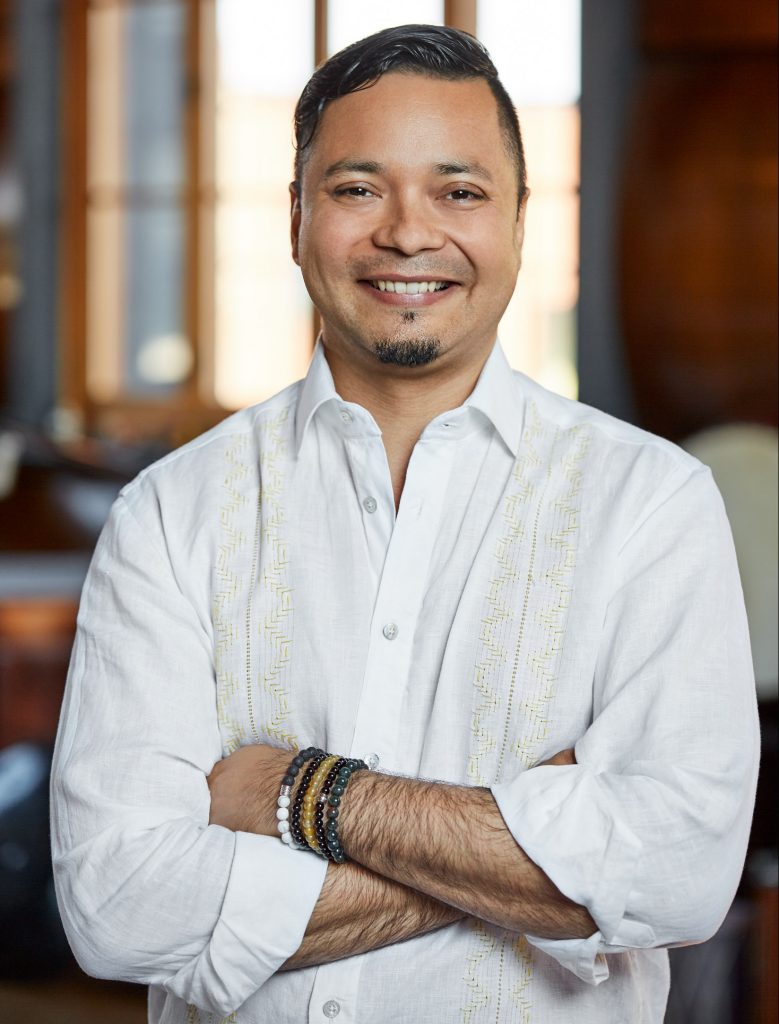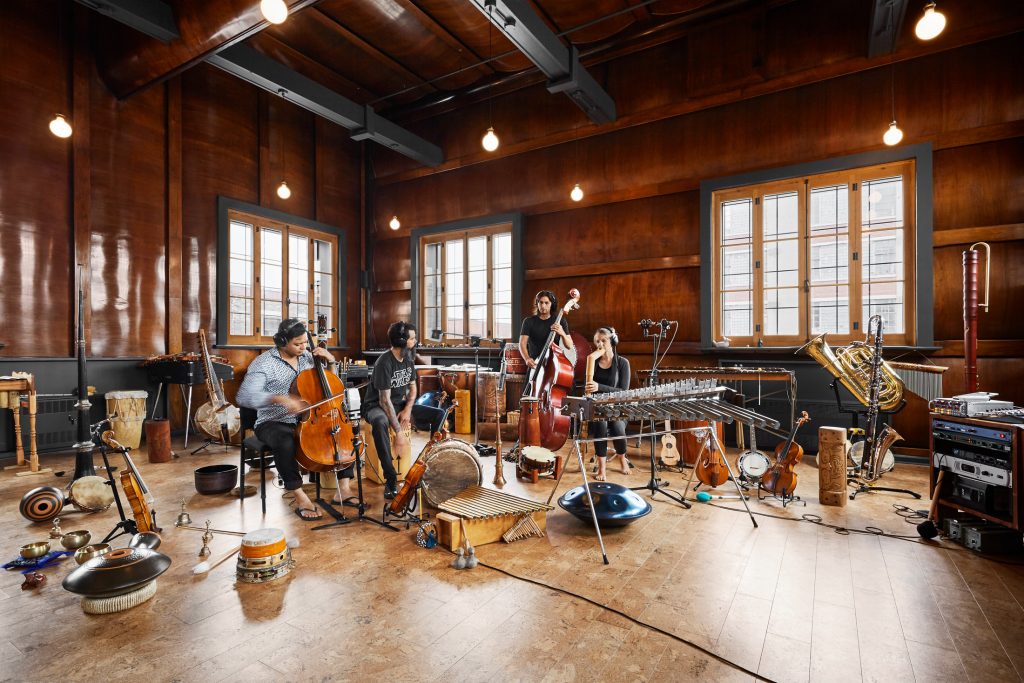
Brian D’Oliveira is a composer based in Montreal, Canada, and the founder & Creative Director of La Hacienda Creative, where they focus on creating unique, bespoke music and sounds for the video-game industry, as well as for film, TV and the manufacturing sector. Some of his credits include Papo y Yo, Tearaway, Resident Evil Biohazard and Little Big Planet 3. As the scores to his work reveal, Brian is also an ethnomusicologist and brings a unique take to his musical projects by studying and incorporating sounds and instruments from cultures all over the world.
Ethnomusicology is in some ways an amalgamation of music and culture. Which came first for you: a passion for composition or a passion for culture?
I actually grew up traveling the world with my mother who was a professional visual artist which had a huge influence on me, and it was during these early times that I realized that they are one and the same. At the age of 6 I learned to play flute in the Andes mountains and at 9 studied classical piano in Vienna just a few blocks from Mozart’s home. Being in those places, eating the food and speaking the language gave me not only context, but an understanding of how music is the sonic reflection of the culture and that they are one and the same.
What got you interested specifically in pursuing ethnomusicology studies?
Given my situation I was in a sense already doing this from an early age and absorbing as much as I could from my surroundings, and since I was seriously trained in visual art during that time I quickly understood how new sounds and forms of music were like a kaleidoscope of new colour palettes and possibilities. So I would spend countless hours practicing on my own and learning from whatever limited resources and people were available around me, I remember some funny moments of hanging out with street buskers and harassing them to teach me. By the time I was 13, I was already performing and starting to amass what would eventually become the collection of instruments that I now have (currently at 900+).
What are some of your favorite instruments you’ve amassed over the years from other cultures?
There are so many of them and each one has its own story and adventures :). One of them is a 150 year old Sarangi (Indian violin) that was built by the equivalent of the ‘Stradivarius of India’, which I found in a rare instrument shop in Chicago after having searched for over a year.
I also recently went to Mexico specifically to do research and found a set of volcanic rocks that can be played like a Marimba in a small lost village that took countless hours of travel to get to, by both car and then foot. I still remember the look on my friend’s face -who had tagged along- when he realized we’d have to lift and carry them back.
I also managed to purchase an original German Baroque cello made around 1780 that belonged to my cello teacher and it has become my most coveted and played instrument.
And last but not least are the Brazilian hunting whistles, which I somehow found were being made in a shop deep in the interiors of Brazil. They ended up becoming some of the most unique and iconic instrument sounds in Papo & Yo .
[youtube https://www.youtube.com/watch?v=kDJlSq3Nn1U&w=640&h=385]
Obviously you incorporate musical instruments and techniques from various cultures into your compositions. What is your process when beginning a project in figuring out what instruments you may be interested in and in finding people to work with and learn from?
This is actually one of my favourite stages and I always do feel the excitement like a kid that has just gotten permission to find some new toys orfriends to play with. But at the same time I take a lot of care and consideration to fully understand where the music is coming from and find out as much as I can about the culture and people whilst figuring out what would be the best fit for the project without it being cliché or being in any way disrespectful. I’m very mindful of cultural appropriation and not crossing that line.
A favourite technique that I used extensively when working on Tearaway was to setup custom playlists of musical references and listen to them every night while sleeping for a few weeks, which allowed me to quickly learn and internalize both the music and subtle aesthetics . And in parallel I will also get in touch with musicians that are from those traditions and places and start a dialogue via video conferencing or old school voice calls. The great thing with music is that generally people are very passionate and happy to share their knowledge and point me in the right direction and/or do intros to the right teacher or instrument maker.
What’s been your favorite experience in regards to recording, building or otherwise interacting with a different cultures’ music or musical instruments?
The journey through this process itself is what I enjoy the most. My musical palette keeps expanding, but it’s the life experiences that ultimately enrich how I go about making music. Traveling to the places and eating the same food, spending time with the people and the environment where the music and instruments come from gives me the inspiration for when I am finally in composing mode and having to produce under pressure and deadlines.
You’ve spent a good deal of your career traveling around the world, meeting with artisans and learning not only how to play instruments, but how to build them as well. What do you think the creative aspects of construction bring to your compositions? And what was the catalyst that began this full-scale approach to not only acquiring instruments but acquiring the knowledge to build them?
There is something very special when you play an instrument that you made completely from scratch with your own hands from raw materials that is hard to explain. It’s both inspiring and gratifying and, from a practical aspect, it also allows me for infinite customization and “tweakability” akin to how one designs sounds working with modular synths, but in the acoustic sense. Because of this, I realized that it was essential for me to invest time into getting the necessary skillset and setup so that I could execute the sounds that I imagine in my head.

What’s been among the greatest challenges you’ve faced in fusing a score with specific instruments or techniques from another culture?
Working with non equi-tempered instruments and non-western scales can have its challenges, especially when having to blend them with modern western instrumentation and aesthetics, so I take great care to make sure these do not clash. The advantage is that since I am usually playing all of the instruments myself I am able to adjust my intonation on the fly accordingly and make it work.
Have you ever used one of these ethnic instruments in a way not perhaps intended in their design or their culture’s normal use that worked well in a score? If so can you describe the technique and end result?
I do that all the time and actually enjoy pushing these types of boundaries. A good example is the score for Papo & Yo where I used a lot of African and Indian instruments and yet I was able to achieve a sound that was still distinctly South American sounding. In Tearaway I used a lot of Brazilian and Yoruba percussion and rhythms that somehow fitted seamlessly into the mainly medieval and folk sounds in the game. There is no specific technique to this since it’s more of a state of mind that is the direct result of my preparation process, and once I have fully understood and internalized the prevalent musical language, I am able to let inspiration take over and perform the ‘unusual’ instrumentation and rhythms in such a way that they seamlessly blend and compliment the piece in a pleasing manner, there were many times that I even surprised myself with the results!
[youtube https://www.youtube.com/watch?v=J2TMFbDotMg&w=640&h=385]
How do you approach learning a new instrument when technique, scales or intonation may be completely different from Western standards?
Sensitivity in the perception of intonation is vital when it comes to this, hence that is why I have been specifically training to understand and perceive microtones in an applicable fashion. Overall I usually spend 2-4 hours a day outside of my studio in focused practice and active listening in order to keep up.
Also along the lines of “focused self learning,” finding the right masters to teach you can save one a lot of time and frustration. A personal experience example of this is how one of my teachers in India basically taught me in just a few very short lessons what would have normally taken me years to learn! So even if you do not have the resources to travel, there are still many great people accessible to learn via video conferencing, which is something that I also do on a regular basis.
Any new desires on the horizon in terms of ethnomusicology? New instruments or techniques you want to learn? New places to travel? New musical legends to study under?
There are so many and so little time! :) I have been dreaming of going to Bali and learning Gamelan music as well as finding a shakuhachi master in Japan to study with. I am also actively developing and furthering my skills in playing Indian classical music and applying it to the cello, and have commissioned from a genius maker in India a custom cello that will have over 32 resonant strings akin to the Indian Sarangi.
[youtube https://www.youtube.com/watch?v=jR232KqllAE&w=640&h=385]
Any words of advice for other composers or sound designers who may not be fully versed in what ethnomusicology is in how they can use the musical history of other cultures to bolster their own skills and palettes?
Ancient & folk musical cultures and traditions are an extremely rich and rewarding and taking the time and effort to learn from them will infinitely enrich your abilities and inspire you to create music and sounds that are uniquely yours, and even small efforts to do this will payback tenfold. Though technology has its advantages, culture, history and nature are an infinite source of inspiration, so the more you are connected with these roots the more you will understand yourself and your voice as a creator.